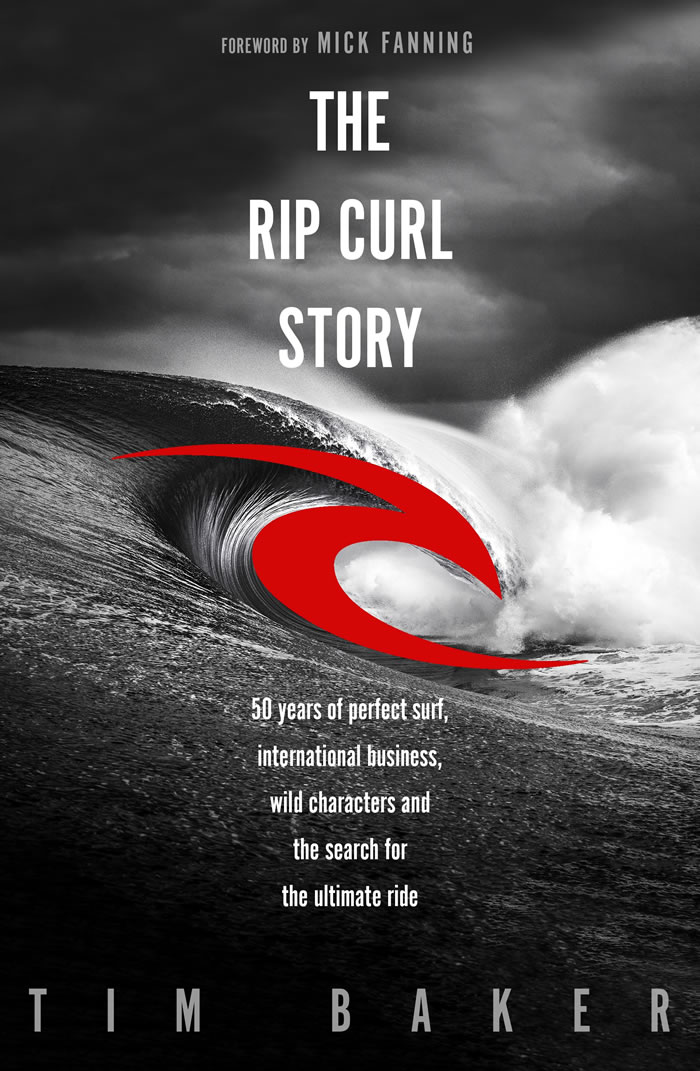The Rip Curl Story |

The Rip Curl Story
50 years of perfect surf international business wild characters and the search for the ultimate ride
By Tim Baker
Paperback / softback 400 pages
The Rip Curl Story is the remarkable tale of two young surfers - Doug 'Claw' Warbrick and Brian Singer - who pursued an audacious dream to make a living in pursuit of the ultimate ride.
The brand they built Rip Curl not only satisfied their own surf wanderlust but also inspired countless others riding the wave of the global youth revolution of the late '60s.
Rip Curl's mantra became 'the Search'- the pursuit of new waves on distant shores new thrills - skiing snowboarding windsurfing - and better equipment to elevate the experience. Along the way they supported the careers of many of the world's great surfers - from Midget Farrelly to Michael Peterson Tom Curren to Damien Hardman Pam Burridge to Stephanie Gilmore and of course Tyler Wright and Mick Fanning.
Bestselling surf writer Tim Baker tells this implausible story in an irresistible series of ripping yarns offering rich life lessons a maverick business primer and a wild ride of adventure good times and outlandish ambitions spectacularly realised.
The Rip Curl Story will make you want to surf more travel further follow through on that great business idea and pursue your own Search.
Buy Online: fishpond.com.au
The Herald Sun Digital Edition: RIPPER RIDE
THE Rip Curl empire was built by two young surfers who wanted to make a living to fund their pursuit of the ultimate ride.
Doug "Claw"Warbrick and Brian Singer started their surfboard company in a shed and grew it into one of the most recognisable brands in the world.
These were the pre-wetsuit days of fires on the beach and wearing footy jumpers in the water to try to stay warm.
"You'd cook yourself by the fire and dash out and catch a couple of waves and come in and warm up"Claw says.
"There was always a fire at the bottom of the stairs at Bells. I hardly ever went there (when) there wasn't a fire. It was just part of the culture and the lifestyle. And there were lots of great stories and banter around fires."
It was around this time that local surfers Vic Tantau and Peter Troy convened the first "surfboard rally". Scheduled for December 1961 at Bells it was actually run in January 1962 and was won by Sydney's Glynn Ritchie.
The following year under the auspices of the newly formed Australian Surfriders Association the Bells was moved to Easter where it has remained ever since now known as The Rip Curl Pro Bells Beach.
Fast-forward to 1967 and intense competition between a group of elite surfers shapers and manufacturers in Brookvale in Sydney's north led to radical new surfboards being designed becoming known as the Shortboard Revolution.
Brian remembers Claw turning up at Lorne High School after a winter surfing trip to Noosa resplendent in the colourful hippy garb of the day and sharing the news of momentous surfboard design developments.
Neither the school nor the local constabulary were thrilled by the appearance of this advance guard of the counterculture movement about to sweep the country.
"The local police sergeant didn't take kindly to Simon Buttonshaw and myself turning up in hippy gear"Claw says. "He drove up in a police van and said 'You freaks should get out of this place' ."
Claw was happy to oblige intent on hightailing it back to Torquay to workshop the business opportunities represented by the new "vee"bottoms on surfboards. He had been running his seasonal pop-up surf shops for a few summers but felt ready to take a bigger leap of faith.
"We were just scratching together enough to get to the next day or next week to have enough money to go surfing when we wanted and not have to turn up to work when the surf was great"Claw says.
They recruited Terry Wall and opened the Bells Beach Surf Shop in a small petrol station owned by a local character called Mumbles Walker opposite the Torquay pub at 42 Bell St.
"Claw was always the thinker in the crew; Brian was the organised one. I don't know what the hell I did. We weren't a very serious crew nor was it extremely organised"Terry says. "They formed a complementary duo Claw being the creative and enthusiastic ideas man Brian the frugal manager.
"Both had moved to Torquay and were willing to give anything a go in order to earn a crust - filling fertiliser bags in Geelong or fixing dings."
A small ad in the local paper announced the arrival of the Bells Beach Surf Shop: "Suppliers of the Best Surfboards and Equipment Available ... Fashion Wear and the Works!"it declared. "Buy your surfing equipment from your own club members. Proprietors: Doug (Claw) Warbrick Terry Wall Brian Singer; the most experienced surfers in the state."
Claw recalls: "The main product we had was the Fantastic Plastic Machine from Keyo Surfboards shaped by Bob McTavish (one of the Sydney surfers and shapers instrumental in the Shortboard Revolution).
"What we had also was this incredibly influential brilliant surfer in Wayne Lynch. Somehow or other we had arranged for one of the very first plastic machines to be for Wayne. I think it was number four. It arrived within a day of me driving back to Torquay. There was a bit of ceremony about it people coming around to take a look.
"Wayne came up to Torquay and he went out at Bells or Winki and surfed like no one had ever done before."
Wayne's innovative surfing was the best possible advertisement for the new design. "He surfed the board a lot up and down the Surf Coast a lot of surfers of the day saw him surf it ... he had a local following"Claw says.
"To me Wayne had a powerful imagination for surfing."
The vee bottom allowed Lynch to lean the board hard over on a rail come square off the bottom and drive vertically up the wave face then carve increasingly radical turns up into and through the lip of the cresting wave.
He was able to surf the way he'd imagined surfing turning constantly in and around the pocket or the curl of the wave giving others a glimpse of the future.
In the stampede to embrace the new equipment demand far outstripped supply providing a crucial early business lesson.
"We had 100 orders in no time but the boards never came. We stopped taking orders at about 200 but the orders went to thousands Australia-wide "Claw remembers.
IT was Brian's turn to travel up to Sydney and do a tour of the surfboard factories to try to secure a supply of the new vee bottoms. His search led him to a progressive young shaper named Shane Stedman who was ready and able to meet the demand for the new design.
Stedman told them they'd need a name and decals for their boards so as Claw Brian and Simon Buttonshaw hung around the surf shop one afternoon they began brainstorming names.
Simon had painted psychedelic artwork on Claw's first vee bottom from McTavish and amid the bright colours and florid designs he painted the words "rip curl hot dog". It was a bit of cosmic wordplay with the new surfing jargon of the day and a variation of the mantra Bob had painted on one of his own early vee bottoms: "hot kid rip board".
"Hot dog"had been a popular term in the US for years but Claw and Brian liked the sound of "rip curl"a more Antipodean expression of this new style of surfing.
Ripping the curl was precisely what Lynch had been able to do on the new equipment. The phrase neatly captured the moment surfing became 3D as surfers like Lynch harnessed centrifugal force to ride up and into the pitching lip of the wave.
The name stuck. Simon drew up some evocative artwork around the new name and Brian remembers going to see the printer who produced decals for every significant board-maker in the country. Claw and Brian were convinced they were well placed to cash in on the mounting surfboard revolution but the pace of change made it difficult to keep up.
"Vee bottoms went out of style as fast as they came in"Claw says. "Within months people started making progressive boards all over Australia. Inches were coming off every week. The old shapers were out of fashion overnight the carpenters and cabinetmakers ."
"Everything was going short very quickly; all we were doing was trading in nine-foot things that nobody wanted"Terry says. "We didn't have a distinct place to do much in terms of repairs and storage. Brian had the masterplan of buying a garage and putting it in the car park of the pub.
"We bought this garage - it was painted black and we painted flowers in psychedelic colours - but the bloody thing was too hot to be inside during daylight hours. That was where we put the increasing number of ninefoot relics that no one wanted and where we did repairs. The garage was where a lot of the action happened."
Claw had an early insight that the surfing industry would need to be about more than just surfboards so they branched out. Much-soughtafter American denim jeans like Levi's and Lee Cooper were originally distributed through surf shops to try to retain their edgy youthculture cool.
If Claw couldn't secure stock he'd go down to Port Melbourne when US Navy ships came in and buy second-hand pairs from the marines. But even these efforts couldn't keep the Bells Beach Surf Shop afloat.
"It petered out; we weren't making any money"Brian says. "For some reason the whole thing came to a grinding halt and I was back teaching science at North Geelong High. It wasn't as nice as Lorne but I do recall that the kids were great."
"I think the whole of Brookvale got overwhelmed with the demand for these new boards"Claw adds. "And we spent too much time surfing and chasing girls."
Terry moved to Newcastle at the end of summer to study for a PhD in chemical engineering and went on to a distinguished career in science and academia. "When I left we had a garage of longboard trade-ins that no one wanted and XXS and XXL surf clothing that fitted no one"he says.
 "Not a resounding financial success. But the first Rip Curl boards had been made Simon had created a great logo working relationships had been created and a company was in the making ... I figured it had been a nice time and said 'See you later' but Claw worked out there was some money owed to me and slung me 20 bucks."
"Not a resounding financial success. But the first Rip Curl boards had been made Simon had created a great logo working relationships had been created and a company was in the making ... I figured it had been a nice time and said 'See you later' but Claw worked out there was some money owed to me and slung me 20 bucks."After that failed experiment Terry figured it was time to get real and forge a legitimate career. "The other reason I moved north was I couldn't see how I could live by the beach and make a living"he says.
THIS IS AN EDITED EXTRACT FROM THE RIP CURL STORY BY TIM BAKER (PENGUIN RANDOM HOUSE RRP $34.99)
Buy Online: fishpond.com.au
❊ More Information ❊
→
www.fishpond.com.au
❊ Also See.. ❊
➼ Rip Curl: Iconic Surfwear
Update Page








